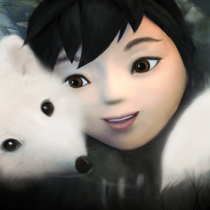Never Alone (Kisima Ingitchuna) is a puzzle platformer that follows a young Iñupiat girl named Nuna and a white fox as they journey through Northern Alaska to find the source of the blizzard that has wreaked havoc on her home village. The game has both single and co-op capabilities as you play as either the girl or fox. I was unable to test out the co-op mode, but I imagine it would have made a few puzzles significantly simpler. Never Alone is similar to Limbo, in the sense that you complete tasks/puzzles through trial and error. Don’t be afraid when little Nuna or the cute little artic fox perish on a regular basis. Trust me, it is the only way to learn and there will be plenty more deaths to come.
The feature that makes Never Alone stand out from other puzzle platformers such as Night Lights, Contrast, and Trine, is its narrative. As I mentioned before, Nuna is a young Iñupiat girl and this journey she is taking to find the cause of the blizzard is actually a well-known story within the Iñupiaq culture. The game in its entirety is a story being told.
Pausing for a moment, I would like to address a matter that caught my attention. There is a game called Last Inua with sort of the same MO as Never Alone. It’s about an Inuit father and son duo fighting for survival in the arctic and the spiritual world that it encompasses. With that mentioned, I do not suggest that these games be considered the same. As I will mention later, Never Alone places emphasis more on the cultural background of the Iñupiaq culture, assigning the game a category in and of itself. Plus Last Inua is more of an adventure platformer than a puzzle platformer.
Alright I have now pressed the metaphorical play button and we shall continue where we left off.

Pretty atmospheric
During the cut scenes and several moments while you are playing the game, a narrator can be heard speaking in the native language of the Iñupiaq. This narrator is presumed to be telling this story to an unforeseen audience as well as yourself. Also to keep with the nature of the storytelling, the cut scenes visually are not of the same design as when playing the game, but rather of the style they would be on a traditional scrimshaw. A scrimshaw is an art form of etching on surfaces in order to pass stories and history through the generations. Because of this, the cut scenes appear as scrimshaw etchings drawn in a design reminiscent of how they are drawn in the Iñupiaq culture. These cut scenes, in a sense, reconnect you to the fact that you are listening to a story, rather than merely going through the motions of playing a game.
One of my favorite parts about Never Alone is the Cultural Insights. The Cultural Insights are video clips that you collect as you traverse through the game. Basically, they are mini documentaries of the Iñupiat people and their culture, as you experience parts of it firsthand through the act of visualizing and interacting with the story being told. The insights are in the perspectives of actual people within this culture, making the information presented more authentic. Not only am I able to play through a game packed full of cultural references to the Iñupiaq culture, but I am also able to learn more about what these references mean in regards to the culture itself. For example, being able to learn the cultural significance of the spirit helpers that appear quite a lot throughout the game was beneficial to my experience of the game as a whole.
The idea of the spirit helpers is a major theme throughout the game. The spirit helpers represent the Iñupiaq culture’s belief of connectedness with everything that has a soul, including other humans, animals, and nature. This explains the bond formed between Nuna and the artic wolf as they work together to complete their quest. While traversing through the game, you start to notice the life in the things around you, such as the fact that trees gain face. Although they are not obvious at first, I think that it is very clever on the designers’ part as it reinforces the fact that everything has a soul. The Iñupiaq culture is very much about being connected to others and the environment, rather than focusing on the individual. Knowing that in the big picture you are just a small spec.

Gorgeous visuals
In regards to the Cultural Insights, personally, I appreciated the insight about the climate change and how it affects the Iñupiat people and their culture. Many are opposed to the idea of climate change, because they do not see any significant changes within their society. It’s beneficial to see climate change from a perspective of someone it is affecting.
In another Cultural Insight, one of the natives mention that listening to these stories was like watching TV or a movie. It is just as powerful and vivid as any movie or TV show and playing Never Alone allows you to experience firsthand just how powerful and vivid these stories can be.
According to Upper One Games, “Never Alone is our first title in an exciting new genre of “World Games” that draw fully upon the richness of unique cultures to create complex and fascinating game worlds for a global audience.”
In my opinion, this a very clever way of learning. Imagine being able to learn about other cultures and their history through games. Think about history teachers using these “World Games” as tools to teach class. Basically being able to utilize a game to completely submerge yourself into a culture. The world just might be a bit more open-minded and understanding of others if this were the case.
When looking at the gameplay of Never Alone, I loved the subtle details that make the game seem more realistic. For example, the game keeps in perspective the physical abilities of the child. Although she may be experienced in taking care of herself, some things such as jumping from too high ledges will kill her.

Not unlike Limbo…
Another aspect that is similar to Limbo, is the fact that Never Alone is a game that builds on itself. As you traverse through the game you come across many challenges, as one would imagine for a little girl and a fox journeying through the icy tundra. These challenges force you to think and come up with strategies. Then similar to an exam, the bosses that you face put everything you’ve learned so far to the test.
As the game comes to a close the narrator says, “I have heard Nasruk tell the story that way,” which brings us full circle back to the beginning where I mentioned that Never Alone is a story being told. You are reminded of this at the end of the game, left only with your thoughts as you reminisce about the story.
Never Alone is not merely a game, it is a story that has been told to you, the audience. And from that story, I believe, the storyteller wants you to take with you the fact that within the Iñupiaq culture, there is a strong and deep connection between humans, animals, and nature. Even when you are lost with no one around, you are never alone.
“If you ever need to find your way home again just look up for me.”






